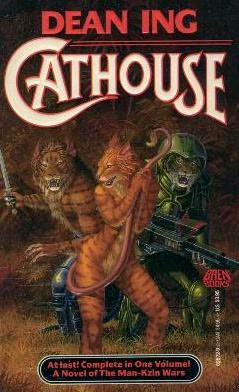Science fiction from Baen Books often comes with a certain reputation. You know the covers – often bold, sometimes brash, and hinting at adventures that are either brilliantly straightforward or bewilderingly… out there. Navigating the Baen catalog is always an experience, and sometimes you stumble upon titles that are so intriguing and bizarre, you simply have to take a look. Dean Ing’s Cathouse is one such book.
 Dean Ing's Cathouse book cover featuring a Kzin
Dean Ing's Cathouse book cover featuring a Kzin
The title itself, Cathouse, paired with a cover that screams pulp sci-fi, is undeniably attention-grabbing. It begs the question: what exactly awaits within these pages? Is it a wild ride, or just plain weird? Curiosity, as they say, can be a powerful motivator, and in this case, it led me down a rather interesting path into what could arguably be called an Alien Cat House of adventure.
What makes Cathouse particularly noteworthy is its setting within Larry Niven’s expansive “Known Space” universe. Niven’s creation is famous for the Kzin, a formidable race of feline warriors who have a history of conflict with humanity. These cat-like aliens, known for their aggression and martial prowess, are central to the “Man-Kzin Wars,” a series of anthologies that emerged when Niven opened up his universe for other writers to explore. He felt perhaps military sci-fi wasn’t his strongest suit, or maybe he just preferred others to play in that particular corner of his sandbox.
 Kzin from Star Trek Animated Series, showcasing their cat-like alien appearance
Kzin from Star Trek Animated Series, showcasing their cat-like alien appearance
Cathouse compiles two novellas originally published in the initial volumes of these Man-Kzin War anthologies. The stories revolve around a character named Locklear, who finds himself in a predicament familiar to sci-fi enthusiasts: captured by the Kzin and subsequently stranded on an uncharted alien planet. If you consider Honor Harrington as sci-fi’s Horatio Hornblower, then Cathouse positions itself as a Robinson Crusoe narrative, but set in the vastness of space. And in this interstellar twist on the classic tale, Friday is not just any companion, but an alien cat-lady.
The alien planet Locklear is marooned on is no ordinary world. It’s revealed to be a habitat constructed by the enigmatic Outsiders, the same ancient race responsible for the Ringworld. These Outsiders have created multiple habitats, each designed to mimic different planetary environments. Locklear’s misfortune lands him in a prehistoric Kzin habitat, adjacent to a prehistoric Earth habitat. While exploring this bizarre alien zoo, he discovers stasis chambers filled with various alien creatures, including, crucially, primitive Kzin. In a move that defines the tone of the adventure, he decides to awaken one of these Kzin females for companionship and survival assistance.
Given the provocative title, Cathouse, one might expect a certain kind of… content. While Dean Ing doesn’t delve into overtly explicit territory, there are definitely moments that raise an eyebrow. Locklear, for instance, names his Kzin companion “Miss Kitty,” later “Kit.” And when Kit suggests waking up more of her kind, it involves Locklear pretending to be her “mate” to navigate their tribal social structure. While the book hints at the possibility of interspecies romance, it never explicitly occurs, with Ing focusing more on the survival and adventure aspects of the story.
After some initial survival struggles, other Kzin arrive, seeking Locklear. This leads to a guerrilla warfare scenario where Locklear and Kit take on the Kzin pursuers, eliminating all but one, named Scarface. Locklear, in a moment of somewhat questionable judgment, extracts an honor-bound oath from Scarface to be a cooperative prisoner. Subsequently, Kit and Scarface depart to… reconnect with their own kind, while Locklear commandeers Scarface’s shuttle and heads over to the Earth habitat next door within this alien zoo. This concludes the first part of Cathouse.
The second novella in Cathouse largely mirrors the first in its narrative structure. Locklear once again faces the challenges of survival, improvising tools and shelters, and eventually discovering another cache of stasis-preserved prehistoric beings – this time, Neanderthals. In a recurring theme, he awakens the most appealing Neanderthal he can find. The first is a young girl, whom he names “Lolita” (a naming choice that is, to say the least, questionable). The second is a fully grown Neanderthal woman named Ruth, and their initial interaction quickly escalates into a sexual encounter, albeit one that happens “off-page.”
 A reconstruction of a Neanderthal woman's face
A reconstruction of a Neanderthal woman's face
The somewhat bizarre nature of this encounter is explained, or perhaps further complicated, by the revelation that Ruth and her tribe are telepathic. Ruth, sensing Locklear’s loneliness, initiated the encounter. Locklear then settles into a routine with Ruth, building a cabin and establishing a life, only to be confronted with the Neanderthal social norms when more of Ruth’s tribe are awakened. He finds himself somewhat perturbed by their non-monogamous society and Ruth’s interactions with other Neanderthal males.
Just when things become… complicated, space pirates (or rather, space mutineers) arrive, disrupting the relative peace. They capture Locklear, attempting to extract information about the planet, employing various methods, including, predictably, a seductive female intelligence agent. However, the twist is that there is no grand secret to the planet, other than its nature as an ancient alien zoo. Ultimately, the pirates decide to punish Locklear by marooning him back in the Kzin habitat. This sets the stage for more adventures, leading to Locklear and Scarface unexpectedly teaming up once again to overcome the pirates and save the day. In this second part, Kit’s role shifts somewhat, becoming more of a damsel in distress, requiring rescue.
Cathouse is, in the end, a surprisingly brisk read, especially considering it’s composed of two combined novellas. Despite its potentially misleading title and cover, it’s not nearly as outlandish or sensational as one might expect. As a survival-in-space adventure story, it functions effectively. The themes of gender, sexuality, and loneliness are present but remain secondary to the action and survival narrative, preventing Ing from venturing too far into potentially awkward territory. One might wonder if a less provocative title, such as “Marooned on Cat Planet,” could have served the book better. Yet, it’s also possible that the name Cathouse is precisely what draws readers in, making them curious about this unusual corner of the sci-fi universe. In my case, it certainly worked, leading me to discover a quirky, if imperfect, adventure within this alien cat house.

